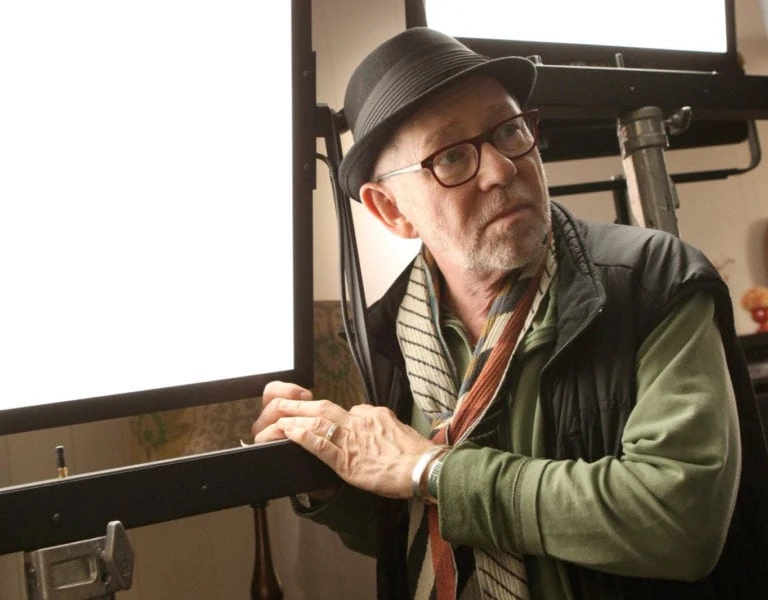
Overview: The Leper is a drama set in 2005 that blends interviews with real paparazzi with the story of Frankie, a paparazzo with no second thoughts on the ethics of his career. That is until he meets Emma, a reality TV star with terminal cancer.
What were your initial discussions about the visual approach for the film? What look and mood were you trying to achieve?
The world and nature of the work of paparazzi played a very big role in figuring out the visual approach in terms of the look and feel. We discussed this a lot, the morality and ethics of the job of a paparazzi. How they need to be willing to act with complete disregard for the people in front of the lens to get the shot, but then in contrast the fact that the photographs being taken contribute to the continuation of the celebrity. It’s in that sense a symbiotic relationship but the question becomes whether it’s mutualistic or parasitic – and I think that’s what the film explores. Regardless of the outcome however, I think it’s reasonable to say that a successful paparazzi needs to be willing to do things that are morally questionable and sometimes pretty awful really. This led us to a grittier, darker look that we felt would visually display that aspect of Frankie’s work. We wanted a sense of weight to the image and to show the world he lives in in the light that reflects the questionable ethics of his work.
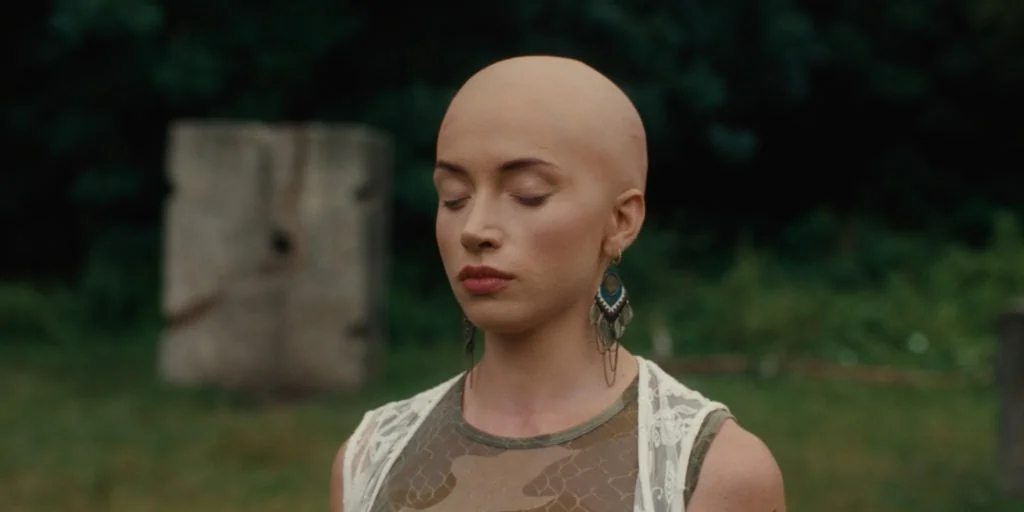
What were your creative references and inspirations? Which films, still photography or paintings were you influenced by?
I remember real life footage of paparazzi at work was a big reference for me to understand the world and the work of paps. We looked at videos of celebrities being surrounded by a swarm of flashing strobes and shouting and short documentaries on paparazzi talking about the work. I found quite a few videos as well of George Bambi, who plays himself in the interview scenes in the film, where he’s in action or speaking about past experiences and those proved incredibly helpful (and actually very entertaining, would recommend). It proved quite important to gain an understanding of these characters to be able to shoot this film as paparazzi are quite foreign to me. There isn’t much of a paparazzi culture back home in Iceland so I had to really get into it and gain an understanding of it.
In terms of what inspired our visual approach, we relied heavily on conversation and discussion about it all and I felt I gained an understanding of what the director, Hugh Mulhern, was after. We looked at a selection of stills from various movies including Uncut Gems, Sexy Beast, Fargo and The Master but I remember not wanting to rely too heavily on references as a means to search for the look, so it was more to quickly communicate ideas rather than looking for inspiration in references. I think references can be really helpful but we’re so incredibly saturated with references today. I really enjoy working without them when you have the time to have extensive conversations with the director and understand on an emotional and narrative level what the look should be reflecting.
What filming locations were used? Were any sets constructed? Did any of the locations present any challenges?
With the bulk of the film being exterior day, a lot of the problems we faced were weather, no surprise there, almost having to shut down the production on one of the days due to torrential rain. We shot the main storyline scenes in multiple locations in a park by Hackney Marshes so logistically it was tricky to get good access and coordinate movement of crew and kit.
Unfortunately, the only parking available was far from set and no vehicles were allowed into the park, which meant we only had trollies for kit and the roundtrip was expensive. It was a great reminder of the idea that less is more and to focus on what’s really important. Everything was shot on location in East London and Beaconsfield so it was a lot of moving around and just trying to plan it in the best way possible.
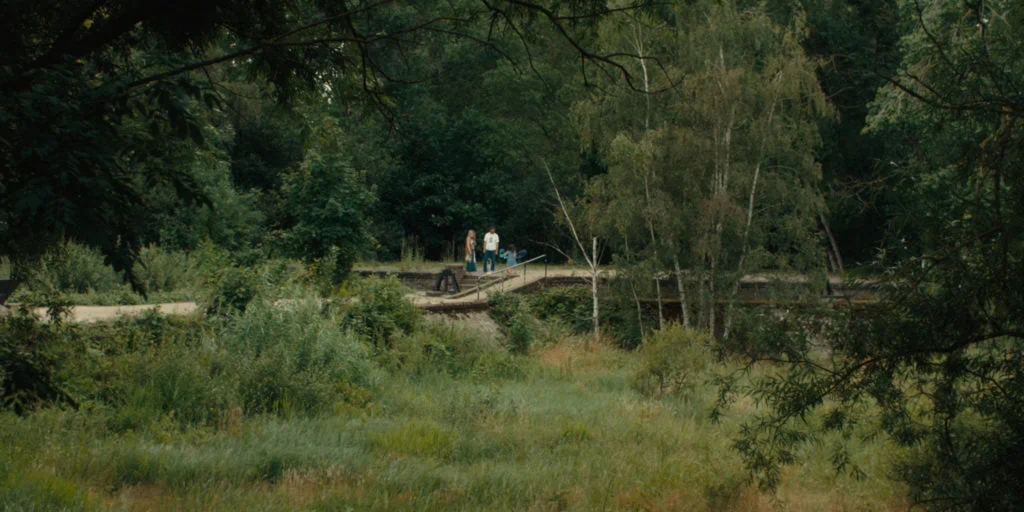
Can you explain your choice of camera and lenses and what made them suitable for this production and the look you were trying to achieve?
Hugh was quite interested in the use of multiple cameras in certain scenes, cross shooting to capture performances simultaineously. We went for a two camera approach for quite a few of the scenes in the park. That posed a bit of a challenge because so much of it was handheld and developing, so myself and B-camera operator Charlie Jenkins had to quickly choreograph our movement to get both cameras into the right place. It was really quite helpful as we could move a lot quicker through the day and I think we really wouldn’t have completed those scenes without both cameras rolling, as we were experiencing intermittent heavy rain showers and lost a lot of time as a result.
It was tricky to not have eyes on B-camera but I had a lot of trust in Charlie which made it a lot easier to let go. I also have to give the camera team such a big shout out as we unfortunately didn’t manage to get a properly crew up for A & B cameras. That meant I had to ask our 2nd AC, Alice Fleur, to step up to pull sharps on B whilst trainee Raul Sherman serviced both cameras, with A-Camera 1st Vaimiti Levbrere overseeing the whole thing. It was a big and uncomfortable ask and a lot for them to manage but they really smashed it and made it all work brilliantly.
The look required some softening of the image, to a certain point. I wanted to explore filtration on this film rather than lenses and I thought it would be interesting to start with sharp and contrast-y glass coupled with the Alexa, and then start breaking down the image with filters, really designing the softness and halation effects of the lens that way on a scene by scene basis. In the end I went with Master Primes and Angenieux Optimo zooms (big shout out to Lee Mackey at Panavision for hooking that up). I thought this might be a more interesting approach as an experiment rather than getting in some old soft vintage glass, relying less on filtration and working more with the particular look of those lenses. After some testing I ended up with all sorts of combinations going with some great filtration, graciously provided by Eren Ibrahim at Tiffen Pinewood, with softfx, glimmerglass, promist, ultracon, black satin and pearlescent, and it provided some very interesting results.
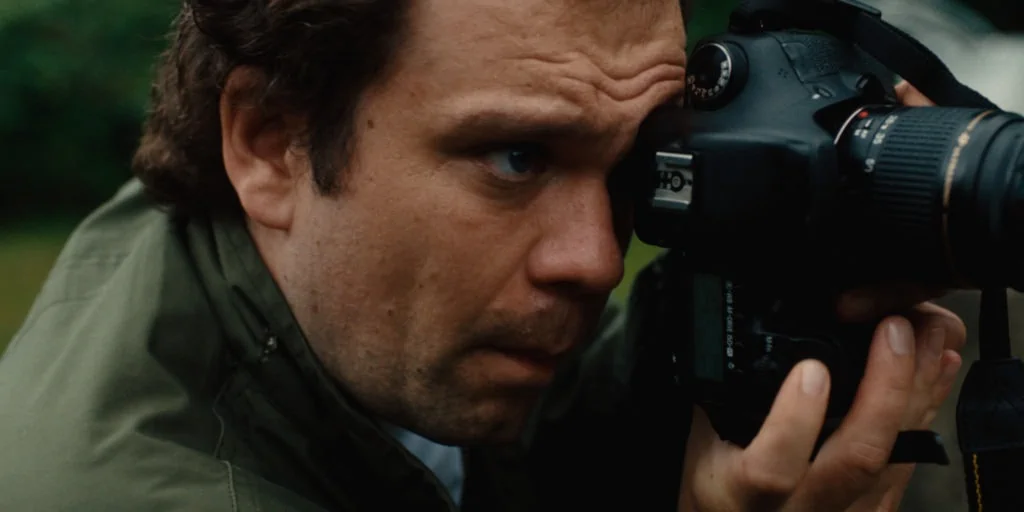
What was your approach to lighting the film? Which was the most difficult scene to light?
I remember jumping up and down in my seat to stay awake on the drive home from the night shoot where we shot the opening scene. We had come up with a a 2 minute steadicam shot that leads you from the street outside a club where we first meet Frankie, through the back gates into the smoking area and into the club where we follow some bouncers and meet some celebrities. We then follow them back out to the street where Frankie waits for them to grab some shots of them leaving. This was one of those nights where you start running as you arrive on set and you don’t stop until you drive off.
We had to light the whole scene on the day, rehearse the shot, shoot it and pack up all in one day. I think I’m right in saying that I completely emptied the lighting truck for that scene, I don’t think there was a single head not in use somewhere on the set because of the ground we had to cover and the fact that we needed a club feel to the space. Still, the thing that really saved my ass was the Panalux LED 22” Spring Ball, which actually wasn’t on my list and came in as a suggestion by James Rosen at Panalux who was such an incredible help.
There was no time to properly light the exterior at the start of the shot, so we had the spring ball on a boom manned by one of our great sparks, Chris Keenan, who walked along with us as I had the wireless remote and dimmed it up and down as we went along. Having a battery powered, remotely controlled spring ball which maintains temperature through any dimming was exactly what we needed. Big thanks to James and Panalux for all the help and making sure that we had everything we needed to make that scene work, and to my gaffer, Lee Wooster, and all the sparks; Chris Keenan, Alex Strachan, Nick Denisov and Teodora Yancheva for making it all work that night.
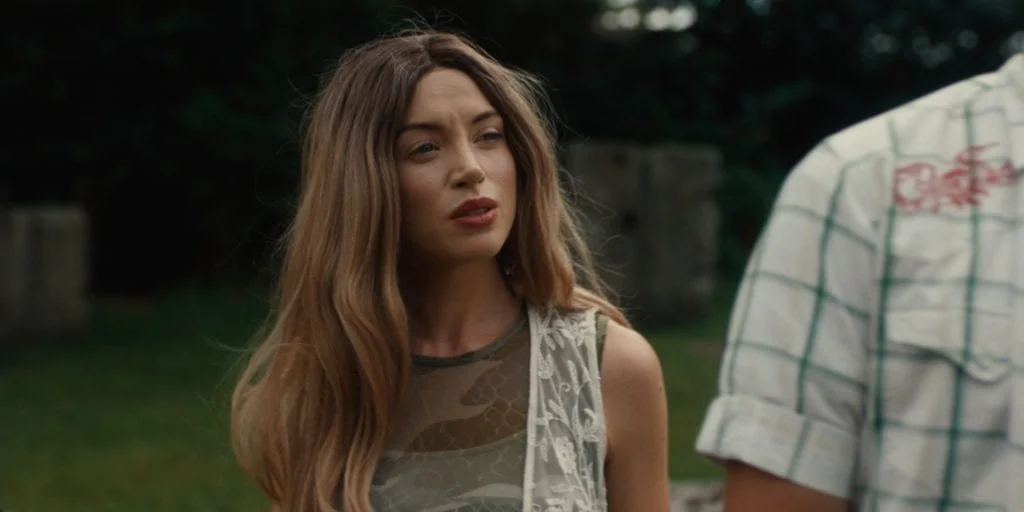
What were you trying to achieve in the grade?
Our discussions from early in the process came back strongly here, trying to push the gritty elements into the image. I had designed a showlut for the film which was based around the discussions Hugh and I had had, pushing a little bit of green into the blacks and warming up the highlights slightly as well as pulling the highlights back a bit. Going into the grade with Nathaniel Skeels, our brilliant colourist, it was clear we wanted to continue working with the ideas established in the LUT but developing it further. We looked for a certain grit in the skin tone, slightly discoloured and quite dense and to really nail the grain level as well as some post softening and halation. I felt we really took it home in the grade by taking the conceptual I spoke about earlier to the visual in a meaningful and practical way.
Which elements of the film were most challenging to shoot and how did you overcome those obstacles?
The night shoot in the night club was a very tricky one and required more planning than we had time for but I think the interview scenes were really tricky. The scene was half scripted but in essence it was all improvised. We had four guys around a pub table; Jack Doolan playing Frankie, Gordon Peaston playing Tel, but then George Bambi and Jack Ludlam as well who are actual paparazzi. I had absolutely no idea what was going to happen with the paparazzi, being non actors and if my memory serves me right they didn’t receive a script.
We went for a three camera setup with two of them cross covering on 10:1 zooms and one of them a master wide. I then sat in video village speaking to the operators on comms, only being able to faintly hear the dialogue through Hugh’s headphones as we had issues with sound transmission. That made it a just that bit more interesting. It was a weird one, it really felt like shooting a live interview because to all intents and purposes it was, but at the same time we were looking for certain topics that served the script. The scene was covered like an interview but the idea was for it to not feel like an interview setup, so in that sense it’s docu/drama fusion and the lighting had to feel a part of the space. It also meant that there was less room for the visual to punctuate what was happening and it was more about making sure we cover the dialogue throughout and punching in for the close-ups at the right moments, as we planned to not do repeat takes.
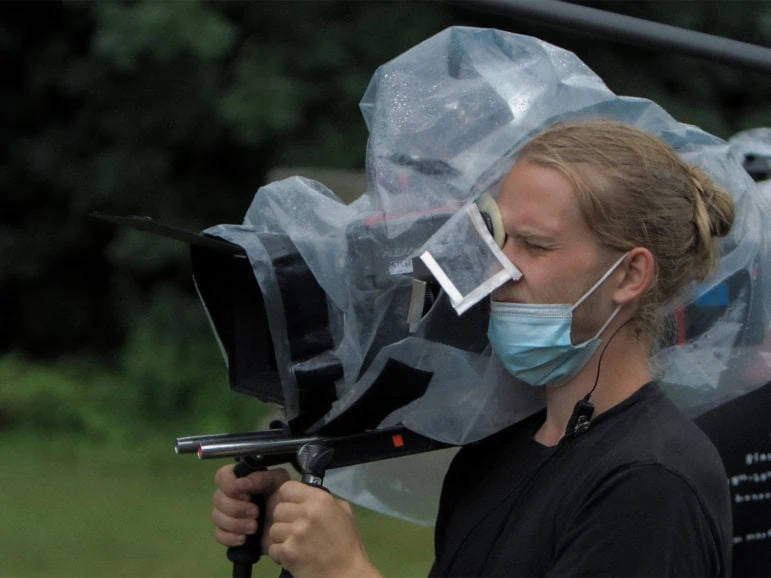
-What was your proudest moment throughout the production process or which scene/shot are you most proud of?
I’d have to say that even though we were all absolutely dripping with sweat and exhausted from the night of shooting the oner, I felt so proud of the whole team for pulling that off. With the time we had and the resources I think that scene wouldn’t have happened if every single person on the technical crew hadn’t given it every single drop of energy and focus. It’s entirely thanks to them that the shot is in the film.
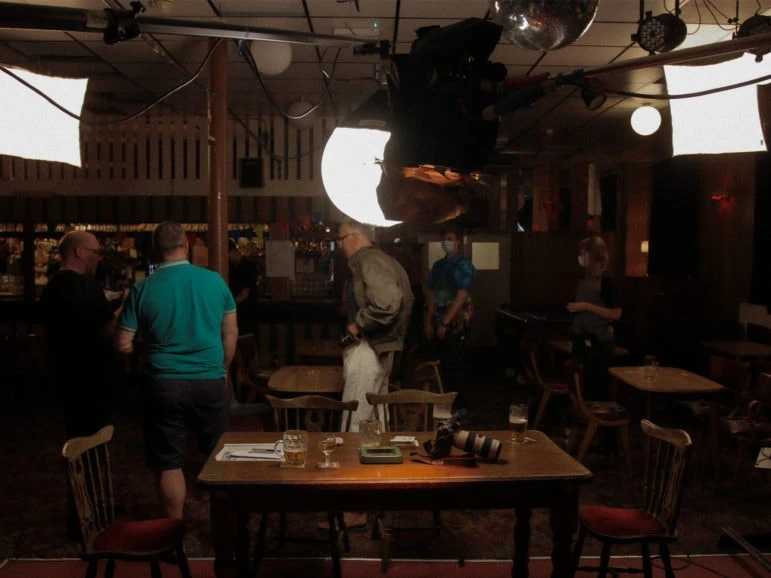
-What lessons did you learn from this production you will take with you onto future productions?
It’s quite hard to point to a single thing but I learned a lot from the whole experience and I’m grateful for the fact that the shoot was incredibly challenging. I’d be disappointed if it hadn’t been difficult and if there hadn’t been mistakes made. This was definitely a shoot that gave me a lot to think about I learned a lot from it in so many different ways.




